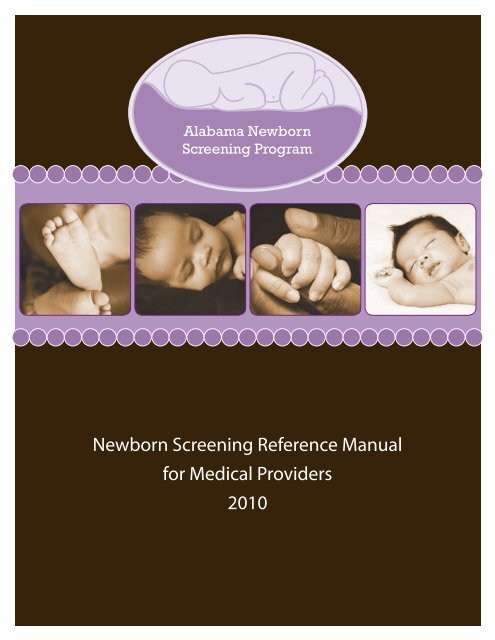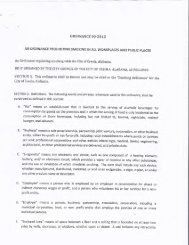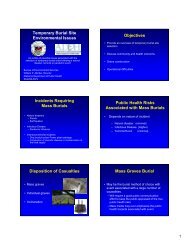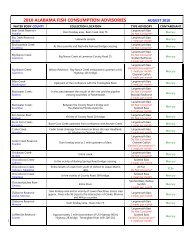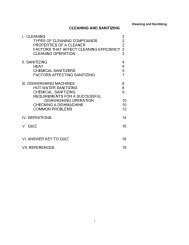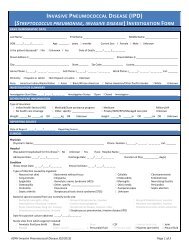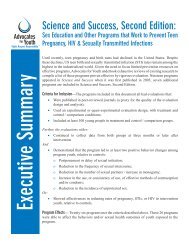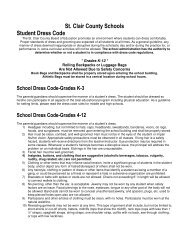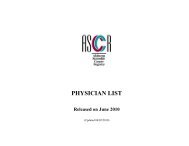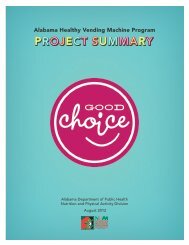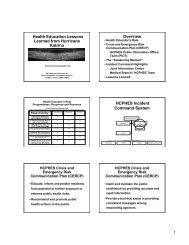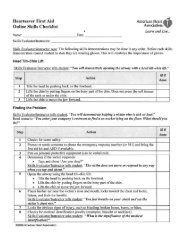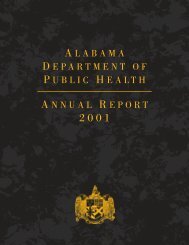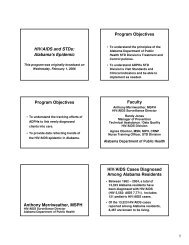Alabama Newborn Screening Program - Alabama Department of ...
Alabama Newborn Screening Program - Alabama Department of ...
Alabama Newborn Screening Program - Alabama Department of ...
Create successful ePaper yourself
Turn your PDF publications into a flip-book with our unique Google optimized e-Paper software.
<strong>Alabama</strong> <strong>Newborn</strong><br />
<strong>Screening</strong> <strong>Program</strong><br />
<strong>Newborn</strong> <strong>Screening</strong> Reference Manual<br />
for Medical Providers<br />
2010
<strong>Alabama</strong> <strong>Newborn</strong> <strong>Screening</strong> <strong>Program</strong> Staff<br />
Cindy Ashley, RN, C, BSN<br />
<strong>Newborn</strong> <strong>Screening</strong> Director<br />
Metabolic and Hemoglobinopathies Follow-Up<br />
PH: 334-206-2971or 1-866-928-6755<br />
FX: 334-206-3063<br />
Amy Strickland, Au. D.,CCC-A<br />
<strong>Newborn</strong> Hearing <strong>Screening</strong> Coordinator<br />
PH: 334-206-2944 or 1-866-928-6755<br />
FX: 334-206-3063<br />
Rachael Montgomery, RN, BSN<br />
<strong>Newborn</strong> <strong>Screening</strong> Follow-up Coordinator<br />
Cystic Fibrosis, Endocrine, and Metabolic Disorders<br />
PH: 334-206-5955 or 1-866-928-6755<br />
FX: 334-206-3063<br />
Abbey Snead, RN<br />
<strong>Newborn</strong> <strong>Screening</strong> Nurse Educator<br />
PH: 334-206-3012 or 1-866-928-6755<br />
FX: 334-206-3063<br />
Melissa Richardson, MS, CCC-A<br />
<strong>Newborn</strong> <strong>Screening</strong> Audiology Consultant<br />
PH: 334-206-2911 or 1-866-928-6755<br />
FX: 334-206-3063<br />
Wendy Caraway<br />
<strong>Newborn</strong> <strong>Screening</strong> Administrative Assistant<br />
PH: 334-206-7065 or 1-866-928-6755<br />
FX: 334-206-3063<br />
Tamika Shepherd<br />
<strong>Newborn</strong> Hearing <strong>Screening</strong> Administrative Assistant<br />
PH: 334-206-2980 or 1-866-928-6755<br />
FX: 334-206-3063<br />
Mailing Address:<br />
<strong>Alabama</strong> <strong>Department</strong> <strong>of</strong> Public Health<br />
<strong>Newborn</strong> <strong>Screening</strong> <strong>Program</strong><br />
P.O. Box 303017<br />
201 Monroe Street<br />
The RSA Tower-Suite 1350<br />
Montgomery, AL 36130-3017<br />
1
Table <strong>of</strong> Contents<br />
<strong>Alabama</strong> <strong>Newborn</strong> <strong>Screening</strong> <strong>Program</strong> .............................................................................. 5<br />
HIPAA .................................................................................................................................. 6<br />
<strong>Alabama</strong> NBS Panel <strong>of</strong> Disorders ........................................................................................ 7<br />
Medical Provider Responsibilities....................................................................................... 8<br />
<strong>Newborn</strong> <strong>Screening</strong> Medical Consultants .......................................................................... 9<br />
<strong>Alabama</strong> Voice Response System ..................................................................................... 10<br />
<strong>Alabama</strong> Voice Response Registration Form .................................................................... 11<br />
<strong>Newborn</strong> <strong>Screening</strong> Brochure Order Form ....................................................................... 12<br />
<strong>Newborn</strong> <strong>Screening</strong> Refusal Form .................................................................................... 13<br />
<strong>Alabama</strong> Birthing Hospitals .............................................................................................. 14<br />
<strong>Alabama</strong> <strong>Newborn</strong> <strong>Screening</strong> Specimen Collection ......................................................... 15<br />
<strong>Alabama</strong>’s Listening (Universal <strong>Newborn</strong> Hearing <strong>Screening</strong>) .......................................... 35<br />
Resources ......................................................................................................................... 43<br />
3
The <strong>Alabama</strong> <strong>Newborn</strong> <strong>Screening</strong> <strong>Program</strong><br />
The <strong>Alabama</strong> <strong>Newborn</strong> <strong>Screening</strong> <strong>Program</strong> establishes protocol to ensure early identification and<br />
follow-up <strong>of</strong> infants affected with certain genetic or metabolic conditions. Early diagnosis may<br />
reduce morbidity, premature death, mental retardation and other developmental disabilities.<br />
The program works in partnership with pediatric specialists throughout the state to ensure all<br />
babies identified with abnormal results receive appropriate follow-up.<br />
The program also seeks to expand relationships with other health pr<strong>of</strong>essionals including<br />
hospitals and pediatricians in the state to enhance existing services and assure objectives are<br />
met. Additionally, there are seven community-based Sickle Cell Organizations who provide<br />
counseling and follow up for children identified with sickle cell disease or sickle cell trait, as well<br />
as two certified Cystic Fibrosis (CF) Care Centers that provide CF care.<br />
The <strong>Alabama</strong> <strong>Newborn</strong> <strong>Screening</strong> Hearing <strong>Program</strong> collaborates with the National Center for<br />
Hearing Assessment and Management (NCHAM) to ensure that all infants and toddlers with<br />
hearing loss are identified as early as possible and provided with timely and appropriate<br />
audiological, educational, and medical intervention. In addition, the <strong>Program</strong> collaborates with<br />
the <strong>Alabama</strong> Early Intervention System(AEIS) to ensure all infants are identified with hearing<br />
loss by three months <strong>of</strong> age and enrolled in AEIS before six months <strong>of</strong> age.<br />
The <strong>Alabama</strong> Bureau <strong>of</strong> Clinical Laboratories (BCL) is the sole provider for blood analysis for the<br />
initial newborn screen. The BCL screens approximately 60,000 babies each year. The BCL also<br />
provides filter paper forms for screening to medical providers.<br />
The goal <strong>of</strong> the <strong>Alabama</strong> <strong>Newborn</strong><br />
<strong>Screening</strong> <strong>Program</strong> is to ensure state<br />
laws, rules and regulations mandating<br />
newborn screening are carried out in<br />
order to identify specific genetic<br />
disorders early and provide<br />
appropriate follow-up care.<br />
5
6<br />
<strong>Newborn</strong> <strong>Screening</strong> <strong>Program</strong> Handbook for Medical Providers<br />
HIPAA<br />
The <strong>Alabama</strong> <strong>Newborn</strong> <strong>Screening</strong> <strong>Program</strong> contacts health providers<br />
daily, and sometimes providers are unsure if information may be shared<br />
due to HIPAA regulations. Please read the notice provided by the ADPH<br />
General Counsel regarding HIPAA guidelines related to newborn<br />
screening.
<strong>Alabama</strong> NBS Panel <strong>of</strong> Disorders<br />
There are twenty-eight disorders currently part <strong>of</strong> the <strong>Alabama</strong><br />
<strong>Newborn</strong> <strong>Screening</strong> Panel <strong>of</strong> Primary Disorders and over fifty total<br />
disorders including secondary conditions. Please see appendix for a<br />
brief description and timeline <strong>of</strong> each disorder.<br />
CURRENT: (As <strong>of</strong> Nov 23, 2009)<br />
3-Methylcrotonyl-CoA Carboxylase Deficiency<br />
3-OH 3-CH3 Glutaric Aciduria<br />
Argininosuccinic Acidemia<br />
Beta-ketothiolase Deficiency<br />
Biotinidase Deficiency<br />
Carnitine Uptake Defect<br />
Citrullinemia<br />
Classical Galactosemia<br />
Congenital Adrenal Hyperplasia<br />
Congenital Hypothyroidism<br />
Cystic Fibrosis (IRT/DNA)<br />
Glutaric Acidemia<br />
Hearing Loss<br />
Hemoglobin S/beta-thalassemia<br />
Hemoglobin SC Disease<br />
Hemoglobin SS Disease<br />
Homocystinuria<br />
Isovaleric Acidemia<br />
Long-chain L-3-OH Acyl-CoA Dehydrogenase Deficiency<br />
Maple Syrup Urine Disease<br />
Medium-chain Acyl-CoA Dehydrogenase Deficiency<br />
Methylmalonic Acidemia<br />
Methylmalonic Acidemia due to mutase deficiency<br />
Multiple Carboxylase Deficiency<br />
Phenylketonuria<br />
Propionic Acidemia<br />
Trifunctional Protein Deficiency<br />
Tyrosinemia Type 1<br />
Very Long-chain Acyl-CoA Dehydrogenase Deficiency<br />
7
8<br />
<strong>Newborn</strong> <strong>Screening</strong> <strong>Program</strong> Handbook for Medical Providers<br />
Medical Provider Responsibilities in <strong>Newborn</strong> <strong>Screening</strong><br />
Medical Providers in <strong>Alabama</strong> are notified <strong>of</strong> abnormal newborn screening results by:<br />
��mail as long as the provider is identified on the specimen collection form<br />
��immediate phone call and mail for potential positives and/or abnormal results<br />
Ex: TSH≥60 and CAH≥150<br />
1. Medical providers are responsible for verifying newborn screening results and should not<br />
assume the newborn screen is normal if they are not notified. Please utilize <strong>Alabama</strong>’s Voice<br />
Response System (AVRS) to obtain newborn screening results.<br />
Provider information may be missing or inaccurate on form<br />
Specimens may be lost in the mail<br />
Hospitals may fail to collect a newborn screen prior to hospital discharge or transfer<br />
2. Medical providers are responsible for ensuring that the infant receives an initial newborn screen<br />
including a hearing screen immediately.<br />
Please mark the filter form First Test only after assuring that no first test was collected<br />
by the birthing facility<br />
Please use the pink sheet attached to filter form for recording hearing results<br />
3. Medical providers are encouraged to consult with an appropriate specialist if needed in order to<br />
develop a plan <strong>of</strong> action for necessary testing and evaluation.<br />
4. Medical providers are encouraged to collect a repeat newborn screen as soon as possible if the<br />
first test is unsatisfactory.<br />
5. Medical providers are responsible for ensuring that the recommended hearing screening<br />
method is used for rescreening <strong>of</strong> infants who fail an initial screen (see page 36).<br />
6. Medical providers are responsible for obtaining a signed statement for parent refusal <strong>of</strong><br />
newborn screening. A newborn screening collection form should be filled out completely with a<br />
statement as to the refusal and mailed to the State Laboratory.<br />
7. Medical providers are encouraged to collect a second newborn screen at two-six weeks <strong>of</strong> age.
<strong>Alabama</strong> NBS Medical Consultants<br />
The <strong>Newborn</strong> <strong>Screening</strong> <strong>Program</strong> encourages consultation with the following medical specialists for<br />
recommendations regarding follow-up or if there are questions about abnormal test results.<br />
Disorders: Specialists:<br />
Endocrine<br />
Congenital Adrenal Hyperplasia (CAH)<br />
Congenital Hypothyroidism (CH)<br />
Hemoglobinopathies<br />
Sickle cell disease, trait conditions and<br />
other hemoglobinopathies<br />
1. USA Medical Center, Endocrinology<br />
Anne Marie Kaulfers, MD 251-405-5147<br />
Christina Hair, RN 251-434-3723<br />
2. Children’s Hospital, Endocrinology<br />
Gail Mick, MD 205-939-9107<br />
Leslie Pitts, CRNP 205-996-9166<br />
1. USA Sickle Cell Center<br />
Felicia Wilson, MD 251-405-5147(3)<br />
Stephanie Durgin, RN 251-415-5172<br />
2. Children’s Hospital, Pediatric Hematology<br />
Thomas Howard, MD 205-939-9285<br />
Sharon Carlton, RN 205-558-2390<br />
Cystic Fibrosis 1. USA CF Care Center<br />
Lawrence Sindel, MD 251-343-6848<br />
2. UAB CF Care Center<br />
Hector Gutierrez, MD 205-939-9583<br />
Metabolic<br />
1.<br />
Staci Self, LGSW 205-939-5494<br />
UAB Genetics<br />
Phenylketonuria (PKU)<br />
S. Lane Rutledge, MD 205-975-6867<br />
Galactosemia<br />
Maria Descartes, MD 205-934-1154<br />
Biotinidase<br />
Amino, Fatty and Organic Disorders<br />
Alicia Roberts, RD 205-996-6983<br />
Metabolic Disorders screened by ADPH NBS <strong>Program</strong>:<br />
Amino Acid Disorders:<br />
argininosuccinic acidemia<br />
citrullinemia<br />
homocystinemia<br />
maple syrup urine disease<br />
phenylketonuria (PKU)<br />
Fatty Acid Oxidation Disorders:<br />
carnitine uptake defect<br />
long chain 3-hydroxyacyl-CoA dehydrogenase deficiency<br />
medium chain acyl-CoA dehydrogenase deficiency<br />
trifunctional protein deficiency<br />
very long chain acyl-CoA dehydrogenase deficiency<br />
Organic Acid Disorders:<br />
beta-ketothiolase deficiency<br />
glutaric acidemia<br />
isovaleric acidemia<br />
methylmalmonic acidemia<br />
proprionic acidemia<br />
3-methylcrotonyl-CoA carboxylase deficiency<br />
9
10<br />
<strong>Newborn</strong> <strong>Screening</strong> <strong>Program</strong> Handbook for Medical Providers<br />
<strong>Alabama</strong> Voice Response System<br />
The AVRS provides 24-hour, 7 days<br />
a week telephone reporting<br />
<strong>of</strong> newborn screening results<br />
in 30 seconds or less<br />
directly through a toll free number,<br />
1-800-566-1556,<br />
and has the capability <strong>of</strong> providing<br />
you with a faxed copy <strong>of</strong> the results.<br />
The <strong>Alabama</strong> Voice Response System (AVRS) requires pre-registration with the <strong>Alabama</strong><br />
<strong>Newborn</strong> <strong>Screening</strong> <strong>Program</strong> and positive identification <strong>of</strong> the caller through two security<br />
checks. Physicians are prompted by the system to enter their state license number<br />
(preceded by zeros, if needed, in order to make a seven-digit number) and a four-digit<br />
personal identification number or PIN.<br />
HOW DO I REGISTER?<br />
Physicians may register with the system by completing the registration form found on the<br />
<strong>Alabama</strong> <strong>Department</strong> <strong>of</strong> Public Health website, http://www.adph.org/newbornscreening/,<br />
or the following page and returning it to the following address:<br />
<strong>Alabama</strong> <strong>Department</strong> <strong>of</strong> Public Health<br />
Attention: Wendy Caraway<br />
P.O. Box 303017<br />
RSA Tower – Suite 1350<br />
Montgomery, <strong>Alabama</strong> 36130-3017<br />
wendy.caraway@adph.state.al.us<br />
HOW DO PHYSICIANS GET A PIN?<br />
Each physician chooses his/her individual four-digit PIN and records the number on the<br />
pre-registration form. The PIN must be four numeric characters. It is the responsibility <strong>of</strong><br />
each physician to safeguard his/her PIN. Do not allow unauthorized access to your<br />
confidential number. If a PIN is ever lost, stolen, forgotten, or if a physician suspects<br />
someone has gained access to it, immediately call the <strong>Newborn</strong> <strong>Screening</strong> <strong>Program</strong> at<br />
334-206-7065 and a new PIN will be assigned.<br />
HOW DOES THE SYSTEM WORK?<br />
Physicians must have available the mother’s social security number or specimen kit<br />
number found on the filter paper collection form preceded by the year <strong>of</strong> the infant’s birth.<br />
Information is provided by recorded voice messages. The infant’s name and date <strong>of</strong> birth<br />
are spelled and verified by user response before any results are given. Information is<br />
provided concerning the need for repeat testing or medical follow-up along with the test<br />
result.
<strong>Alabama</strong> Voice Response System Registration Form<br />
Participating physicians must complete and return this form in order to register for<br />
the automated <strong>Alabama</strong> <strong>Newborn</strong> <strong>Screening</strong> Voice Response System (AVRS).<br />
(PLEASE PRINT)<br />
Name <strong>of</strong> Physician ______________________________________________________<br />
Name <strong>of</strong> Facility________________________________________________________<br />
Mailing Address _______________________________________________________<br />
______________________________________________________________________<br />
Area Code/Telephone Number __________________________________________<br />
Area Code/Fax Number ________________________________________________<br />
E-Mail Address ________________________________________________________<br />
Physician’s State License Number ________________________________________<br />
Personal Identification Number(PIN) _____________________________________<br />
______________________________________________________________________<br />
Signature <strong>of</strong> Physician __________________________________________________<br />
Please fax or mail to:<br />
Wendy Caraway<br />
<strong>Alabama</strong> <strong>Department</strong> <strong>of</strong> Public Health<br />
P.O. Box 303017<br />
201 Monroe Street<br />
RSA Tower, Suite 1350<br />
Montgomery, <strong>Alabama</strong> 36130-3017<br />
Fax: 334-206-3063<br />
If you have any questions please call 334-206-7065 or 1-866-928-6755<br />
11
12<br />
<strong>Newborn</strong> <strong>Screening</strong> <strong>Program</strong> Handbook for Medical Providers<br />
<strong>Newborn</strong> <strong>Screening</strong> Brochure Order Form<br />
Hospital/Practice Name: ___________________________________________________<br />
(Please spell out complete name)<br />
Mailing Address: _______________________________________________________________<br />
(No P.O. Boxes please)<br />
City/Zip Code: ______________________________________________________<br />
Telephone: ________________________________________________________<br />
Contact Person: ____________________________________________________<br />
Brochure Number: ADPH-FHS-____________________<br />
*Please see below for English versions <strong>of</strong> the NBS Brochures or visit our website at<br />
www.adph.org/newbornscreening. Include “S” after brochure number for the Spanish version.<br />
Name <strong>of</strong> Brochure: ______________________________________________________________<br />
Quantity Requested (comes in packets <strong>of</strong> 100): _____________________________________<br />
*Please use a separate order form for each brochure ordered*<br />
Please call, fax or e-mail this order form to Wendy Caraway at:<br />
334-206-7065 (phone)<br />
334-206-3063 (fax)<br />
wendy.caraway@adph.state.al.us<br />
FHS-223 FHS-534 FHS-536 FHS-533
<strong>Newborn</strong> <strong>Screening</strong> Refusal Form<br />
The American Academy <strong>of</strong> Pediatrics and the <strong>Alabama</strong> <strong>Department</strong><br />
<strong>of</strong> Public Health strongly recommend <strong>Newborn</strong> <strong>Screening</strong> for all<br />
infants<br />
Child’s Name:____________________________________ Date <strong>of</strong> Birth:_________________<br />
Name <strong>of</strong> Delivery Hospital: ___________________________________________________<br />
Parent/Legal Guardian: ______________________________________________________<br />
My child’s medical provider ________________________________ has advised me that my child<br />
(named above) should participate in the newborn screening program.<br />
� As the parent or legal guardian <strong>of</strong> my child (named above), I choose to decline<br />
participation in my state’s newborn screening program, on the grounds that such tests conflict<br />
with my religious tenets and/or practices (as allowed by the Code <strong>of</strong> <strong>Alabama</strong> 1975, 22-20-3).<br />
I have been provided information about newborn screening in my state and the importance <strong>of</strong> early<br />
identification <strong>of</strong> the disorders. I have had the opportunity to discuss these with my child’s medical<br />
provider, who has answered my questions regarding the recommended screening. I understand the<br />
following:<br />
The purpose and need for newborn screening.<br />
The risks and benefits <strong>of</strong> newborn screening.<br />
If my child does not participate in newborn screening, the consequences <strong>of</strong> a late diagnosis<br />
may include delayed development, mental retardation, or death.<br />
My child’s medical provider, the <strong>Alabama</strong> <strong>Department</strong> <strong>of</strong> Public Health, and the American<br />
Academy <strong>of</strong> Pediatrics strongly recommend that all newborns be screened for certain disorders.<br />
If my child has one <strong>of</strong> my state’s screened conditions, failure to participate in newborn<br />
screening may endanger the health or life <strong>of</strong> my child.<br />
Nevertheless, I have decided at this time to decline participation in the newborn screening program for<br />
my child as indicated by checking the box above.<br />
I acknowledge that I have read this document or it has been read to me in its entirety, and I fully<br />
understand it.<br />
Parent/Legal Guardian Signature_________________________________ Date _________________<br />
Witness _______________________________________ Date_______________________<br />
I have had the opportunity to re-discuss my decision not to participate in my state’s newborn screening<br />
program and still decline the recommended participation.<br />
13
14<br />
<strong>Newborn</strong> <strong>Screening</strong> <strong>Program</strong> Handbook for Medical Providers<br />
Huntsville Hospital<br />
UAB Hospital<br />
St. Vincent’s Hospital<br />
<strong>Alabama</strong> Birthing Hospitals<br />
As <strong>of</strong> 2010, <strong>Alabama</strong> has 54 birthing hospitals listed below in birth rank order.<br />
Brookwood Medical Center<br />
Baptist Medical Center East<br />
USA Children & Women’s Hospital<br />
Providence Hospital<br />
DCH Regional Medical Center<br />
East <strong>Alabama</strong> Medical Center<br />
Northport Hospital<br />
Southeast <strong>Alabama</strong> Medical Center<br />
Flowers Hospital<br />
Jackson Hospital<br />
Northeast AL Regional Medical Center<br />
Mobile Infirmary Medical Center<br />
St. Vincent's East<br />
Gadsden Regional Medical Center<br />
Shebly Baptist Medical Center<br />
Thomas Hospital<br />
Eliza C<strong>of</strong>fee Memorial Hospital<br />
Medical Center Enterprise<br />
Cullman Regional Medical Center<br />
Marshall Medical Center South<br />
Crestwood Medical Center<br />
Baptist Medical Center South<br />
Walker Baptist Medical Center<br />
Vaughan Regional Medical Center<br />
2010 Birth #<br />
5159<br />
3810<br />
3589<br />
3479<br />
3432<br />
2808<br />
1858<br />
1700<br />
1676<br />
1581<br />
1574<br />
1343<br />
1324<br />
1272<br />
1178<br />
1165<br />
1160<br />
1156<br />
1114<br />
1017<br />
909<br />
895<br />
869<br />
851<br />
849<br />
780<br />
771<br />
Helen Keller Memorial Hospital<br />
DeKalb Regional Medical Center<br />
South Baldwin Regional Medical Center<br />
Springhill Memorial Hospital<br />
UAB Medical West<br />
Trinity Medical Center<br />
Russellville Hospital<br />
Decatur General Hospital<br />
Athens Limestone Hospital<br />
Russell Hospital<br />
Coosa Valley Medical Center<br />
Andalusia Regional Hospital<br />
Princeton Baptist Medical Center<br />
Parkway Medical Center<br />
Cooper Green Hospital<br />
Jacksonville Regional Medical Center<br />
Citizens Baptist Medical Center<br />
Highlands Medical Center<br />
George H. Lanier Memorial Hospital<br />
D.W. McMillan Memorial Hospital<br />
Marshall Medical Center North<br />
Bryan W. Whitfield Memorial Hospital<br />
Monroe County Hospital<br />
North Baldwin Infirmary<br />
Jackson Medical Center<br />
Crenshaw Community Hospital<br />
Grove Hill Memorial Hospital<br />
2010 Birth #<br />
737<br />
721<br />
640<br />
637<br />
628<br />
619<br />
556<br />
534<br />
489<br />
457<br />
440<br />
432<br />
423<br />
415<br />
361<br />
360<br />
359<br />
353<br />
337<br />
316<br />
306<br />
258<br />
245<br />
231<br />
165<br />
153<br />
102
<strong>Newborn</strong> <strong>Screening</strong> Specimen Collection<br />
The following pages provide<br />
information regarding specimen collection<br />
� <strong>Alabama</strong> Bureau <strong>of</strong> Clinical Laboratory Notice<br />
Please see this notice <strong>of</strong> changes made to the protocol for testing specimens received by<br />
the <strong>Newborn</strong> <strong>Screening</strong> Laboratory.<br />
� Hemoglobinopathy Instructions for “B” Filter Forms<br />
Please see the instructions for completing the “B” filter form when hemoglobinopathy<br />
testing is needed.<br />
� Lessons Learned: NBS Collection<br />
Please see these helpful tips for improving specimen collection that were noted at the<br />
NBS Coordinator Conference held August 2009.<br />
� <strong>Alabama</strong> Bureau <strong>of</strong> Clinical Laboratory NBS Collection Guidelines<br />
Please see the <strong>Newborn</strong> <strong>Screening</strong> Collection Guidelines for the approved method <strong>of</strong><br />
blood collection by the <strong>Alabama</strong> Bureau <strong>of</strong> Clinical Laboratories.<br />
� Sick Infant Blood Collection Protocol Changes (March 25, 2010)<br />
The <strong>Newborn</strong> <strong>Screening</strong> protocol for premature or sick infants has been recently<br />
updated by the <strong>Alabama</strong> <strong>Newborn</strong> <strong>Screening</strong> Advisory Committee. Please see the<br />
protocol for recent changes.<br />
� Whatman® Neonatal <strong>Screening</strong> Reference Form<br />
Please see this reference form to review steps for blood collection and handling<br />
procedure.<br />
� Whatman® Simple Spot Check Reference Form<br />
Please see this reference form to review examples and possible causes <strong>of</strong> invalid or<br />
unsatisfactory results.<br />
� <strong>Newborn</strong> <strong>Screening</strong> Provider Update Form<br />
Please see the Provider Update Form if your contact information has changed.<br />
� Filter Paper Reorder Form<br />
Please see the Filter Paper Reorder Form to order newborn screening specimen kits.<br />
15
20<br />
<strong>Newborn</strong> <strong>Screening</strong> <strong>Program</strong> Handbook for Medical Providers<br />
<strong>Alabama</strong> <strong>Newborn</strong> <strong>Screening</strong> Premature or<br />
Sick Infant Blood Collection Protocol<br />
November 2, 2010<br />
The following <strong>Newborn</strong> <strong>Screening</strong> protocol for premature or sick infants has been developed<br />
by a task force <strong>of</strong> pr<strong>of</strong>essional medical providers and consultants and has been approved<br />
by the <strong>Alabama</strong> <strong>Newborn</strong> <strong>Screening</strong> Advisory Committee. These recommendations are in<br />
keeping with the recommendations <strong>of</strong> the Clinical Laboratory Standards Institute (CLSI) as<br />
well as the standards required by the <strong>Alabama</strong> <strong>Department</strong> <strong>of</strong> Public Health Laboratory.<br />
It is recommended that when collecting <strong>Newborn</strong> <strong>Screening</strong> blood samples involving<br />
premature or sick infants, who have been admitted to the NICU for five days or longer,<br />
the following protocol be used:<br />
Premature or Sick Infants-<br />
• The first <strong>Newborn</strong> Screen Specimen is to be collected when infant is admitted to the<br />
NICU. * (Prior to transfusions)<br />
• The second (B form sample) <strong>Newborn</strong> Screen Specimen is to be collected between<br />
5-7 days <strong>of</strong> age or prior to discharge if discharge is to be at less than 5 days <strong>of</strong> age.<br />
(At least 72 hours post transfusions)<br />
• If on TPN at time <strong>of</strong> second NBS, collect the third NBS specimen 2 days after TPN is<br />
discontinued or upon discharge from NICU, whichever comes first.<br />
• In very low birth-weight infants (less than 2000 grams), hypothalamic immaturity<br />
could obscure meaningful TSH elevations so T4/TSH levels are recommended<br />
between 4-12 weeks.<br />
*(Note: If the infant is admitted to the NICU and the expected stay is less than 5 days, the specimen<br />
should be collected according the well baby collection protocol.)
<strong>Alabama</strong> <strong>Department</strong> <strong>of</strong> Public Health<br />
Bureau <strong>of</strong> Clinical Laboratories<br />
<strong>Newborn</strong> <strong>Screening</strong> Collection Guidelines<br />
Timing <strong>of</strong> <strong>Screening</strong>:<br />
First Test (“A” form) – This specimen is tested for Hypothyroidism, CAH, Cystic Fibrosis,<br />
Galactosemia, Hemoglobinopathies, Biotinidase Deficiency, Amino Acid Disorders, Fatty Acid<br />
Disorders, and Organic Acid Disorders.<br />
Full Term<br />
Infants<br />
A newborn screening test should be collected when the infant is 24-48<br />
hours <strong>of</strong> age and on adequate protein feeding for > 24 hours. If the infant is discharged<br />
prior to 24 hours <strong>of</strong> age or feeding < 24 hours, the parent or guardian must be informed<br />
<strong>of</strong> the importance <strong>of</strong> obtaining a repeat test before one week <strong>of</strong> age.<br />
Home Births The <strong>Newborn</strong> <strong>Screening</strong> Statute applies to all infants born in <strong>Alabama</strong>. The birthing<br />
attendant is responsible for collecting the newborn screening test. It is recommended<br />
Extended<br />
Hospital Stay<br />
(low birth<br />
weight/sick infants)<br />
Transitioning<br />
Infants<br />
that the test is collected at 24-48 hours <strong>of</strong> age.<br />
It is recommended that a specimen be collected upon admission to the NICU if the infant<br />
is expected to receive TPN or transfusions unless the infant is so unstable that it cannot<br />
be done safely. For further information, a copy <strong>of</strong> the <strong>Alabama</strong> <strong>Newborn</strong> <strong>Screening</strong><br />
collection is attached.<br />
Infants admitted to NICU for short term observation but are not receiving TPN or<br />
transfusions should have a specimen collected according to the Full Term Infant<br />
Protocol.<br />
Dying Infants If an infant is likely to die, it is appropriate to collect a newborn screening specimen.<br />
While dying infants may have abnormal results as a response to organ failure, the<br />
specimen may also provide a diagnosis <strong>of</strong> an early onset screening disorder.<br />
Older Infants The American Academy <strong>of</strong> Pediatrics recommends that physicians know the screening<br />
status <strong>of</strong> all children in their care. While older infants may enter the practice without<br />
evidence <strong>of</strong> a newborn screen, the <strong>Alabama</strong> <strong>Department</strong> <strong>of</strong> Public Health’s <strong>Newborn</strong><br />
<strong>Screening</strong> <strong>Program</strong> has established standards and cut<strong>of</strong>fs for newborns and infants and<br />
therefore cannot accept specimens on children older than 12 months <strong>of</strong> age.<br />
Transfused<br />
Infants<br />
Transferred<br />
Infants<br />
Section 22-20-3 (as amended in 1987) <strong>of</strong> the Code <strong>of</strong> <strong>Alabama</strong> states that all infants must<br />
be administered a reliable test for PKU, Hypothyroidism, CAH, Galactosemia, Abnormal<br />
Hemoglobin’s, Biotinidase, Amino Acid Disorders, Fatty Acid Disorders and Organic Acid<br />
Disorders and that the testing be performed by the Public Health Laboratory.<br />
Special Considerations:<br />
A specimen should be collected prior to transfusion regardless <strong>of</strong> age or treatments<br />
unless the infant is so unstable it cannot be done safely. If the specimen is not collected<br />
prior to transfusion, collect a specimen greater than 72 hours post transfusion. Another<br />
specimen should be collected at 3-4 months post transfusion for Hemoglobinopathies,<br />
Biotinidase, and Galactosemia. If a Galactosemia condition is suspected and the<br />
specimen was not collected prior to transfusion, place the infant on a lactose-free diet<br />
until a definitive diagnosis can be made.<br />
The transferring facility must collect a specimen prior to transfer regardless <strong>of</strong> age or<br />
treatments unless the baby is so unstable that is cannot be done safely. If the specimen<br />
cannot be obtained prior to transfer, the transferring facility must ensure that the next<br />
facility is aware <strong>of</strong> the need for collection <strong>of</strong> the newborn screening specimen.<br />
21
22<br />
<strong>Newborn</strong> <strong>Screening</strong> <strong>Program</strong> Handbook for Medical Providers<br />
Parent<br />
Refusal<br />
Parents may refuse newborn screening only for religious reasons. Parents who refuse<br />
under this condition should sign a statement that is placed in the infant’s medical record.<br />
A newborn screening collection form should be filled out completely with a statement<br />
as to the refusal and mailed to the State Laboratory.<br />
Second Test (“B” form) – This specimen is tested for Hypothyroidism, CAH, Amino Acid Disorders,<br />
Fatty Acid Disorders, Organic Acid Disorders, Cystic Fibrosis, Biotinidase, and Galactosemia.<br />
Note: This specimen is not routinely tested for Hemoglobinopathies. If no valid test has been done<br />
for this disorder, please see instructions below for collection <strong>of</strong> requested repeat specimens.<br />
1. A second newborn screening specimen should be collected at 2-6 weeks <strong>of</strong> age (4 weeks optimal)<br />
on all full term infants with a normal first test screen.<br />
2. If the first test specimen was collected when the infant was greater than one week <strong>of</strong> age but less<br />
than two weeks <strong>of</strong> age, the second test specimen should be collected at 4-6 weeks <strong>of</strong> age.<br />
3. If the first test specimen was collected after two weeks <strong>of</strong> age, a second (“B”) specimen need NOT<br />
be collected.<br />
Requested Repeat (“B” form)<br />
1. A repeat specimen may be requested by the State Laboratory when the results are abnormal or<br />
questionable. The specimen should be collected in the time frame indicated by the report. The<br />
“Retest-Prior Abnormal” box must be marked on the collection form.<br />
2. If the first test is unsatisfactory for testing, a repeat test should be collected as soon as possible.<br />
The “Retest-Prior Unsat” box must be marked on the collection form.<br />
Collection <strong>of</strong> Filter Paper Bloodspot Specimen<br />
Materials needed for Blood Collection:<br />
1. Gloves<br />
2. 70% isopropyl alcohol pads<br />
3. Dry sterile gauze pads<br />
4. Sterile sticking device with a point not greater than 2.4 mm in depth (the most effective method is<br />
the use <strong>of</strong> scalpel bladed lancets)<br />
5. <strong>Newborn</strong> <strong>Screening</strong> filter paper collection form (CL-89) with protective envelope<br />
Bleeding Procedure:<br />
1. The preferred puncture site is indicated by the shaded areas on the heel.<br />
The least hazardous sites for heel puncture are medial to a line drawn<br />
posterior from the middle <strong>of</strong> the big toe to the heel or lateral to a similar<br />
line drawn on the other side extending from between the 4 th and 5 th<br />
toe to the heel.<br />
2. Warm the infant’s foot if necessary using warm water, towel, or chemical<br />
pack. Heat sources should not exceed 42°C and should not be left in<br />
contact with the skin for a prolonged period.<br />
3. Disinfect the skin with alcohol pads and allow to air dry. Vigorous rubbing during this step<br />
stimulates blood flow to the area.<br />
4. Puncture the skin in one continuous motion using a sterile sticking device with a tip
Collecting the Blood Spots:<br />
1. Before collecting the blood, fold back the protective flap to expose the filter paper. Do not touch or<br />
handle the filter paper before or after applying the blood.<br />
2. Lightly touch the filter paper against a large drop <strong>of</strong> blood and allow a sufficient quantity <strong>of</strong> blood to<br />
soak through to completely fill the circle. Apply blood to one side <strong>of</strong> the filter paper only, allowing<br />
full saturation <strong>of</strong> each circle. Either side <strong>of</strong> the filter paper may be chosen. Fill all circles. Do not<br />
layer successive small drops <strong>of</strong> blood to the same circle. Avoid touching or smearing the blood<br />
spots.<br />
3. If blood flow is diminished, repeat the bleeding procedure with sterile equipment.<br />
4. Once all the circles have been filled, press a sterile gauze pad to the puncture site and hold the<br />
infant’s foot above the level <strong>of</strong> the heart until bleeding has stopped.<br />
5. Dry the blood spots on a level, non-absorptive surface away from direct sunlight and at room<br />
temperature for at least 4 hours.<br />
6. After blood spots are completely dry, replace the protective flap and place them in the protective<br />
envelope (do not use plastic) and mail to the State Laboratory within 24 hours.<br />
Guidelines and Possible Sources <strong>of</strong> Error:<br />
The following guidelines may help eliminate unsatisfactory<br />
specimens or erroneous test results.<br />
1. Do not touch any part <strong>of</strong> the filter paper circles<br />
before, during, or after collection.<br />
2. Collect the specimen on the proper <strong>Newborn</strong><br />
<strong>Screening</strong> collection form.<br />
3. Complete all demographic data. This information is vital for interpretation <strong>of</strong> newborn screening<br />
results and for identification and location <strong>of</strong> infants for follow-up <strong>of</strong> abnormal test results.<br />
a) Always indicate any medications that may affect test results.<br />
b) Mark the proper feeding status.<br />
c) Always note any transfusions <strong>of</strong> red blood cells.<br />
4. Wipe away the first drop <strong>of</strong> blood to remove tissue fluids and alcohol. Do not “milk” the puncture<br />
site.<br />
5. Do not expose the specimen to heat or humidity at any time. Do not dry on heater, in microwave,<br />
with a hair dryer, or in the sunlight. Do not place in plastic bags, leave in hot mailbox, or hot car;<br />
proteins and enzymes will be destroyed.<br />
6. Ensure that the specimen is properly dried before replacing the protective flap or before placing in<br />
the protective envelope.<br />
7. Dry specimens in a horizontal position. Hanging wet specimens will cause heavier red cells to<br />
migrate to the end <strong>of</strong> the circle causing an uneven saturation.<br />
8. Do not superimpose blood drops on top <strong>of</strong> each other.<br />
9. Apply blood to only one side <strong>of</strong> the filter paper.<br />
10. Collecting blood samples after feeding promotes better blood flow.<br />
Improperly prepared blood spots and<br />
failure to complete the information<br />
form accurately constitute a major<br />
problem for the testing laboratory.<br />
Good blood spot preparation will<br />
assure prompt and accurate testing.<br />
11. Do not allow specimens to come in contact with water, feeding formulas, antiseptics, urine, etc.<br />
23
24<br />
<strong>Newborn</strong> <strong>Screening</strong> <strong>Program</strong> Handbook for Medical Providers<br />
1<br />
4<br />
5<br />
10<br />
11<br />
12<br />
13<br />
18<br />
21<br />
Completing the Demographic Data<br />
Always complete the specimen collection form using a black or blue ball point pen and print legibly to ensure that the<br />
patient is identified properly.<br />
6 7 8 9<br />
2<br />
3<br />
14<br />
19<br />
20<br />
15<br />
16<br />
17<br />
21
1 Name field – enter the patient’s last name and first<br />
name (if applicable)<br />
3 Medicaid field – enter the infant’s Medicaid number if<br />
applicable<br />
5 Time <strong>of</strong> Birth field – enter in military format, failure to<br />
use military format may result in erroneous test results<br />
since many lab tests are based on the age <strong>of</strong> the infant<br />
at the time <strong>of</strong> collection.<br />
7 Multiple Births field – if this birth is a multiple birth<br />
(twins, triplets, etc.), check the multiple<br />
9 Sex field – Mark the check box M for male or F for<br />
female<br />
11 Time <strong>of</strong> Feeding field – enter the time <strong>of</strong> the first<br />
protein feeding in military format.<br />
13 Infant’s age field – enter the infant’s age at the time <strong>of</strong><br />
specimen collection.<br />
15 Race field – mark the appropriate box for the infant’s<br />
race<br />
17 Mother’s information fields – enter the mother’s<br />
information in the appropriate fields. Mother’s social<br />
security number should be entered accurately. This will<br />
allow the submitting facility to access test results more<br />
readily and ensures that infants needing immediate<br />
follow-up can be located quickly.<br />
19 Home birth field – check the home birth box if the<br />
infant was born outside <strong>of</strong> the birthing facility with a<br />
birthing attendant present.<br />
21 Submitter field – enter the name and address <strong>of</strong> the<br />
facility submitting the specimen. Do not use<br />
abbreviations as there are facilities with similar names.<br />
An address label may be attached in this area as long as<br />
it does not obscure any other fields or hang <strong>of</strong>f <strong>of</strong> the<br />
edge <strong>of</strong> the form.<br />
2 Medical Record field – enter the patient’s medical record<br />
number. This number is for the submitting facility to identify<br />
the patient when the report is received<br />
4 Birth date field – enter the birth date in the format<br />
MM/DD/YY (required field)<br />
6 Birth Weight field – enter the infant’s birth weight in pounds<br />
and ounces. If the infant is more than one month <strong>of</strong> age, enter the<br />
current weight. The laboratory sets standards and cut<strong>of</strong>fs for some<br />
tests using weight. Indicating the weight helps to ensure accurate<br />
test results and eliminate the need for unnecessary repeat<br />
specimens.<br />
8 Gestational Age field – enter the gestational age as<br />
number <strong>of</strong> completed weeks<br />
10 Date <strong>of</strong> 1 st Feeding field – enter the date <strong>of</strong> the first<br />
protein feeding. This includes TPN feeding.<br />
12 Type feeding field – mark the box beside the appropriate<br />
feeding type. Feeding type refers to the type <strong>of</strong> nutrition that the<br />
infant is receiving. If the infant is receiving more than one type <strong>of</strong><br />
feeding, mark all that apply.<br />
14 Transfused field – mark the box if the infant has ever received a<br />
transfusion <strong>of</strong> red blood cells. Enter the date <strong>of</strong> the last transfusion<br />
prior to specimen collection in the format MM/DD/YY and the time<br />
<strong>of</strong> the last transfusion prior to specimen collection in military<br />
format. The date and time <strong>of</strong> transfusion are important for the<br />
laboratory to determine whether the test results are valid. Failure<br />
to indicate transfusions can result in an infant with a detectable<br />
disorder being missed due to the presence <strong>of</strong> donor cells in the<br />
newborn screening specimen.<br />
16 Type <strong>of</strong> test fields – mark the “First Test” box if the<br />
specimen is the first one collected on this infant. Mark the<br />
“Routine Second Test” box if the specimen is the routine<br />
second test specimen collected on this infant. If a prior test<br />
on this infant was reported as unsatisfactory, mark the<br />
“Retest – Prior Unsat” box. If a prior test on this infant was<br />
abnormal and the State Laboratory requested a repeat<br />
sample, mark the “Retest –Prior Abnormal” box. Including<br />
the lab number <strong>of</strong> the previous test will help to ensure that<br />
the appropriate tests are ordered.<br />
18 Physician fields – enter the full name and phone number<br />
<strong>of</strong> the physician who will be providing direct care after<br />
discharge. There are many physicians with the same last<br />
name and therefore cannot always be identified by last<br />
name only. The physician listed on the collection form<br />
becomes the physician-<strong>of</strong>-record and will be contacted by<br />
the laboratory in the event <strong>of</strong> an abnormal test result.<br />
Responsibility for follow-up remains with the physician <strong>of</strong><br />
record until another practitioner actively accepts it. All<br />
physicians should be registered in the State Laboratory data<br />
base to ensure timely receipt <strong>of</strong> test reports.<br />
20 Hearing field – On the “A” form enter the date that the<br />
hearing screen was performed in the format MM/DD/YY and<br />
check the appropriate boxes to indicate the results <strong>of</strong> the<br />
hearing screen and the testing method used. On the “B”<br />
form the hearing data will be entered on the pink form.<br />
22 Lab use field - Do not write or place labels in this area. This<br />
space is used by the laboratory to attach a unique<br />
identification number to the specimen for use in the<br />
laboratory.<br />
25
26<br />
<strong>Newborn</strong> <strong>Screening</strong> <strong>Program</strong> Handbook for Medical Providers<br />
Hemoglobinopathy Repeats<br />
If a repeat Hemoglobinopathy (Hgb) is needed, please complete the “B”<br />
filter form by:<br />
1. Marking Retest-Prior Abnormal (Requested by State)<br />
2. Writing Hgb as shown below<br />
Note: Hgb testing will not be routinely performed on the “repeat” or “second test”<br />
specimen unless a repeat test is requested by the <strong>Alabama</strong> <strong>Newborn</strong> <strong>Screening</strong><br />
Laboratory.<br />
*Regarding home births: If you are aware that an infant was born outside <strong>of</strong> a hospital<br />
setting for any reason, it is your responsibility to ensure that the infant receives an initial<br />
newborn screen and newborn hearing screen immediately. If you use the B filter paper,<br />
please mark the box indicating a first test, and you may use the pink sheet to record<br />
hearing screen results.<br />
Please attached NS.RS.Form here<br />
*<br />
7 hgb<br />
NS.rs.4.2.10
Lessons Learned: NBS Collection<br />
<strong>Newborn</strong> Screens can have dramatic impact to the welfare <strong>of</strong><br />
the infant and the family, and it is important to understand the<br />
significance <strong>of</strong> screening both from a medical outcome and a<br />
legal liability standpoint.<br />
Here is a summary <strong>of</strong> best practices that <strong>Alabama</strong> hospital<br />
staff found helpful in improving specimen collection at their<br />
facility.<br />
1. Storage <strong>of</strong> the filter paper both pre-use and post-use can be very important. If the<br />
paper is stored in a dry, hot environment such as an unventilated warehouse it will<br />
affect the performance <strong>of</strong> the paper. Always try to store paper at room temperature<br />
and room humidity. Post-use storage should be in keeping with NBS lab guidance<br />
(©ID Biological Systems Report).<br />
2. The type <strong>of</strong> lancet used can have a definite effect on the specimen collected. The<br />
“switch blade” type lancet achieves better blood flow than the puncture type. This<br />
could make a difference in your blood collection (©ID Biological Systems Report).<br />
3. Limit the number <strong>of</strong> people allowed to actually draw NBS blood to a very few, well<br />
trained individuals to reduce unsatisfactory specimens (<strong>Alabama</strong>NBS Coordinator<br />
Conference 2009).<br />
4. Track the performance <strong>of</strong> these collectors and re-train or substitute as necessary if<br />
unsatisfactory or invalid results occur (<strong>Alabama</strong> NBS Coordinator Conference 2009).<br />
5. Perform a quality control inspection <strong>of</strong> all specimens before mailing them to the NBS<br />
lab. At a minimum check for the following:<br />
� Complete and correct demographic information<br />
� Complete and correct NBS hearing test information<br />
� Record who collected the sample<br />
� Confirm results are received on each specimen submitted<br />
If you believe you are having issues with specimen collection, please contact the NBS<br />
State Health Laboratory at 334-260-3400.<br />
27
���������� ���������� ������� ������ ���� ���<br />
������������� ��� ��� ������� ������� �����<br />
������� ����� ����� ���� ������ ����� ����������<br />
����� �������<br />
��������� ��� ������������ �� ��� �����������<br />
������ ����� ������� �� �������� ��� ������� ��<br />
���� ���� ������� ���� �������� �� �� ��������<br />
������ �� ����� ����� ����������� ����<br />
���������� ����� �� �����������<br />
�������� ���� � ������������������ � ��������� ����<br />
����� ��� �������� �����<br />
��������<br />
���������<br />
����� �������� ����������<br />
��� �������� ���������<br />
����� ���� ���� ���� ������ ��������� ����<br />
���� ����� �� �� ��� �� ��� ����� �� ����<br />
��������<br />
�������� ���� ���� ������� ����� ���� ���<br />
���� ������� ����� ����<br />
����<br />
29
30<br />
<strong>Newborn</strong> <strong>Screening</strong> <strong>Program</strong> Handbook for Medical Providers<br />
��������� ����� ���� ���� ����� ����� ���� ���� �������<br />
����� ���� ����� ������� ����� ����� ���� �� �����<br />
�������� ����� ������ ����� �� ����� ����� ����� �����<br />
����� �� ���� ������� ��� ���������� ���� ������ ����<br />
������ ����������� �� ����� ����� ����� ���<br />
������� ����� ����� ���� ������ ������������<br />
�������� ��� �� ������� �� ��� ���� �����������<br />
��� �������� ������ ����� ����� �� ��� ���� �� ������<br />
����� �����<br />
����������� �������� �� ��� ��� ���� ����� ���������� �� �������<br />
����� ��������� ������� �� ��� ���� ������ ��<br />
���� �� ���� ���������� ����� ������ �� �����<br />
���� �� ����������� ������ ����� � ������� ��<br />
���� �� ���� �������� ���� ������ ��<br />
���������� ���� ���� ������������� �����������<br />
���� ����� ����� �� � ���� ������ ����� ����<br />
��������� ������� ��� � ������� ��<br />
���� ������<br />
�� ����<br />
��������� ���� �� ������� ����������<br />
������ �� ����� �� �����������<br />
����� ������� � ������� ���� � ���� ������������� � ���� �������������� � ���� �������������� � ������� ����������������<br />
������ � ������� ������������� ��� � ���� ��� ��� ���� ������ � ���� ��� ��� ���� ������ � ������� �����������������������<br />
����� � ������� ����� �� � ���� ��� ��� � ���� ���� � ���� ��� ��� � ���� ���� � ������� ���������������������<br />
���� ������� � ������� ���� ������� ��� ��� � ���� ��� ���� ���� � ���� ��� ���� ���� � ������� ���������������<br />
���������������������������������������<br />
����
������<br />
����<br />
�����<br />
�� �������� �������� ������������ ��� ��������<br />
�� �������� ������� ��������� �� ��������<br />
�� �������� ��� ��� ������ ��������<br />
�� �������� ������� ���������������<br />
�� �������� ������� �������� ���������� ��<br />
�������������<br />
�� �������� �������� ����� ������<br />
�� �������� ������� ������� �� ��������<br />
�� �� ������<br />
����� ���������<br />
������� ��������� �������� �������<br />
� ������� �� ������ ����� ���������<br />
����� � ���������� �������� �� ����� �� ���� �������<br />
�� ���������� ���� ��� ���������� ������ �� ��� ������<br />
������ ���� ��� �������� ������� ���� ������ �� ���<br />
����� ���������� ����� �� ����� �� ����� �����<br />
���� ���� ���� �� ��� ���� ���������� �������<br />
����� �������� �� �������� ������<br />
� �������� ������ ����� ������ ����� ��� ���������� ������ ������ �� ������ �����<br />
��� ������ ������� �� ������ �����<br />
� �������� ����� �� ������ ����� ���� � ��������� �����<br />
� �������� ������ ����� �� ���� ���� ������� ���� ������ �� �������� ����� �� ����������<br />
���� �� ���� ������ �� ������� ������ ������ �� ����� ����� �������� �����������<br />
� �������� ����� ���� � ��������� ���� �� ����� �������<br />
� ������� �������� ������ ������ ��� � ������� �� ���� ������<br />
� �������� ������ ����� �� ������ ������ ������� ���� � �������<br />
� �������� ����� �� ���� ����� �� ������ ������<br />
� ��������� �� ��������� �� ���� ����������� ��� �������� �����<br />
� �������� ������ ����� �� ���� ���� ������� ���� ������ �� �������� ����� ��<br />
���������� ���� �� �������� �������� ���������� ���������� ������ ���� ������<br />
�� ������� ����� ������ ������ �� ����� ����� �������� �����������<br />
� �������� ����� ����� �� ������ �����<br />
� ��� ������ ������� ���� �������� ���� ������ ������ ���� ���������<br />
� �������� ������ ����� �� ���� ���� ������� ���� �������� ���� ������� ����<br />
� ��������� ���� ����������� �������� ���� ������������<br />
� ������ �������� �����������<br />
� �������� ����� �� ������ ����� ���� � ��������� �����<br />
� �������� ��� ���� ������ �� ������ ����� �� ����� ���� ������� ������<br />
� ������� ������ �� ���� ����� �� ������ ������<br />
����� ������� � ������� ���� � ���� ������������� � ���� �������������� � ���� �������������� � ������� ����������������<br />
������ � ������� ������������� ��� � ���� ��� ��� ���� ������ � ���� ��� ��� ���� ������ � ������� �����������������������<br />
����� � ������� ����� �� � ���� ��� ��� � ���� ���� � ���� ��� ��� � ���� ���� � ������� ���������������������<br />
���� ������� � ������� ���� ������� ��� ��� � ���� ��� ���� ���� � ���� ��� ���� ���� � ������� ���������������<br />
����������� �������� ��<br />
��� ��� ���� �����<br />
���������� �� �������<br />
������������������������������� ���������<br />
����<br />
31
<strong>Alabama</strong> <strong>Newborn</strong> <strong>Screening</strong> <strong>Program</strong><br />
Reorder Form<br />
In order to assure that you have an adequate supply <strong>of</strong> newborn screening materials available,<br />
complete this form and mail or fax it to the State Health Laboratory at the address below when<br />
your stock has reached a 2-4 week supply.<br />
Name <strong>of</strong> Hospital or Doctor:<br />
Street/Shipping Address ONLY No P.O. Box:<br />
City, State, and Zip Code:<br />
Telephone Number:<br />
Signature and Title:<br />
BUREAU OF CLINICAL LABORATORIES<br />
SHARON P. MASSINGALE, PH.D., HCLD(ABB) ♦ DIRECTOR<br />
ALABAMA DEPARTMENT OF PUBLIC HEALTH<br />
Bureau <strong>of</strong> Clinical Laboratories<br />
<strong>Newborn</strong> <strong>Screening</strong> Division<br />
8140 AUM Drive, Zip 36117-7001<br />
P.O. Box 244018, Zip 36124-4018<br />
Montgomery, AL<br />
FAX (334) 260-3439<br />
Number <strong>of</strong> “A” (first test) <strong>Newborn</strong> <strong>Screening</strong> Kits Requested:<br />
*Note “A” forms are sent to Hospitals and Birthing Centers only.<br />
Number <strong>of</strong> “B” (second test) <strong>Newborn</strong> <strong>Screening</strong> Forms Requested:<br />
Please indicate the number <strong>of</strong> newborn infants that you screen per month:<br />
NOTE: All orders will be shipped within 5 working days <strong>of</strong> receipt. Please plan your orders<br />
accordingly. We cannot make emergency shipments.<br />
33
34<br />
<strong>Newborn</strong> <strong>Screening</strong> <strong>Program</strong> Handbook for Medical Providers<br />
M E M O R A N D U M<br />
TO: Health Care Providers<br />
FROM: <strong>Newborn</strong> <strong>Screening</strong> Division<br />
Bureau <strong>of</strong> Clinical Laboratories<br />
STATE OF ALABAMA<br />
DEPARTMENT OF PUBLIC HEALTH<br />
DONALD E. WILLIAMSON, M.D.♦ STATE HEALTH OFFICER<br />
BUREAU OF CLINICAL LABORATORIES<br />
SHARON P. MASSINGALE, PH.D., HCLD(ABB) ♦ DIRECTOR<br />
SUBJECT: <strong>Newborn</strong> <strong>Screening</strong> Provider Update<br />
In order to provide more efficient service in providing newborn screening forms we are<br />
updating our provider list. It would be <strong>of</strong> a great assistance to us if you would fill out the<br />
following information and return it as soon as possible to:<br />
ALABAMA DEPARTMENT OF PUBLIC HEALTH<br />
Bureau <strong>of</strong> Clinical Laboratories<br />
<strong>Newborn</strong> <strong>Screening</strong> Division<br />
P.O. Box 244018<br />
Montgomery, AL 36124-4018<br />
FAX (334) 260-3439<br />
Thank you for your prompt attention to this matter.<br />
Group or Name <strong>of</strong> Practice:<br />
Street/Shipping Address ONLY No P.O. Box:<br />
City, State, and Zip Code:<br />
Telephone Number:<br />
Approximate Number <strong>of</strong> Specimens per Month:<br />
NAMES OF ALL PHYSICIANS THAT SEND NEWBORN SCREENING SPECIMENS:<br />
Mail: P.O. Box 244018 Phone: 334/260-3400 Shipping: 8140 AUM Drive<br />
Montgomery, AL 36124-4018 Fax: 334/274-9800 Montgomery, AL 36117-7001
<strong>Newborn</strong> Hearing<br />
The following pages provide information<br />
regarding newborn hearing<br />
� <strong>Newborn</strong> Hearing <strong>Screening</strong><br />
Please see the <strong>Newborn</strong> Hearing <strong>Screening</strong> information if there are questions regarding<br />
hearing loss and testing methods.<br />
� Guidelines for Pediatric Medical Home Providers<br />
Please see the hearing screen algorithm for appropriate referral and follow up.<br />
� Audiological Evaluation Form<br />
Please see the audiological evaluation form to report newborn hearing results for<br />
outpatient/diagnostic testing.<br />
� Children’s Rehabilitation Service (CRS) Hearing Clinics<br />
Please see the directory for CRS Hearing Clinics in <strong>Alabama</strong> to obtain an appointment for<br />
newborns who fail the initial hearing screen in the hospital.<br />
35
36<br />
<strong>Newborn</strong> <strong>Screening</strong> <strong>Program</strong> Handbook for Medical Providers<br />
What is hearing loss?<br />
There are two main types <strong>of</strong> hearing loss:<br />
<strong>Newborn</strong> Hearing <strong>Screening</strong><br />
1. Conductive hearing loss – occurs when sound cannot enter into the inner ear. This may be<br />
caused by wax buildup, fluid in the ear, or structural abnormalities. It can usually be corrected<br />
with medical or surgical intervention.<br />
2. Sensorineural hearing loss – occurs when there is damage to the inner ear. This may be caused<br />
by diseases, birth injury, toxic drugs, viruses, or genetic syndromes.<br />
In addition, there are various degrees <strong>of</strong> hearing loss. They include mild, moderate, severe, and<br />
pr<strong>of</strong>ound hearing loss. It is important to note that milder hearing losses or hearing losses that affect<br />
only one ear may not be apparent. Thus, it is important to follow up even though a baby may appear to<br />
hear normally.<br />
Why should a baby’s hearing be screened?<br />
Statistics show that between one to three newborns per 1000 have some degree <strong>of</strong> hearing loss.<br />
Although these statistics indicate that it is unlikely that a baby will have a hearing loss, if there is one, it is<br />
important that you know about it as soon as possible. The first two years <strong>of</strong> a baby’s life are critical for<br />
learning speech and language. It is important to diagnose hearing problems early because a hearing loss<br />
could affect a baby’s speech and language development.<br />
How is the hearing screen performed?<br />
There are two types <strong>of</strong> screening methods that may be used. Both tests are very safe, take only minutes<br />
to perform, and are non-invasive. Most babies sleep through the hearing screening.<br />
1. Auditory Brainstem Response (ABR) – determines the infant’s ability to hear s<strong>of</strong>t sounds by<br />
inserting miniature earphones and attaching electrodes to measure brain-wave responses to the<br />
sound in order to determine if the sounds are heard normally. This diagnostic testing is<br />
recommended for high risk newborns admitted to the NICU greater than five days by the Joint<br />
Committee on Infant Hearing (JCIH) and should be completed as a second test method if an<br />
infant is initially tested with ABR.<br />
2. Otoacoustic emissions (OAE) – measures inner ear function by inserting a miniature microphone<br />
in the ear canal via a s<strong>of</strong>t probe tip and measuring tones from the ear by sending responses to a<br />
special computer.<br />
What if a baby does not pass the hearing screening?<br />
If a baby does not pass the first screening an attempt may be made to repeat the screening before a<br />
baby goes home, or it may be scheduled after going home. Different types <strong>of</strong> hearing tests will be<br />
recommended if a baby does not pass the second screening. It is recommended that all testing be<br />
completed by 3 months <strong>of</strong> age, and infants with hearing loss be enrolled in appropriate intervention<br />
services as early as possible, but no later than 6 months <strong>of</strong> age.
<strong>Newborn</strong> <strong>Screening</strong> <strong>Screening</strong> Completed Diagnostic Evaluation Intervention Services<br />
Birth Before 1 Month Before 3 Months Before 6 Months<br />
Identify a Medical Home<br />
for every infant<br />
Hospital-based<br />
Inpatient <strong>Screening</strong><br />
OAE/AABR* (only AABR or<br />
ABR if NICU* 5+ days)<br />
All results sent to<br />
Medical Home<br />
Pass<br />
No more<br />
than 2<br />
screening<br />
attempts<br />
recommended<br />
prior to<br />
discharge<br />
Home<br />
Births a<br />
Failed<br />
Screen, or<br />
Missed, or<br />
Incomplete ac<br />
Early Hearing Detection and Intervention (EHDI)<br />
Guidelines for Pediatric Medical Home Providers<br />
Outpatient<br />
Re-<strong>Screening</strong> a<br />
(OAE/AABR*)<br />
All results sent to<br />
Medical Home<br />
and State EHDI*<br />
<strong>Program</strong><br />
Pass<br />
Fail c<br />
Pediatric Audiologic<br />
Evaluation b with<br />
Capacity to Perform:<br />
Normal<br />
Hearing<br />
OAE*<br />
ABR*<br />
Frequency-specific<br />
tone bursts<br />
Air & bone conduction<br />
Sedation capability<br />
(only needed for some infants)<br />
Ongoing Care <strong>of</strong> All Infants d ; Coordinated by the Medical Home Provider<br />
Hearing<br />
Loss<br />
Unilateral/Bilateral;<br />
Sensorineural/<br />
Conductive/Mixed;<br />
Mild/Moderate/<br />
Severe/<br />
Pr<strong>of</strong>ound<br />
Audiologist Reports to State<br />
EHDI* <strong>Program</strong><br />
Every child with a permanent<br />
hearing loss, as well as all normal<br />
follow-up results<br />
Refer to IDEA* Part C<br />
Coordinating agency for early<br />
intervention<br />
Team Advises Family About:<br />
All communication options;<br />
different communication modes;<br />
assistive listening devices<br />
(hearing aids, cochlear implants,<br />
etc); parent support programs<br />
Medical & Otologic Evaluations<br />
To recommend treatment and<br />
provide clearance for hearing<br />
aid fitting<br />
Pediatric Audiology<br />
Hearing aid fitting and monitoring<br />
• Provide parents with information about hearing, speech, and language milestones<br />
• Identify and aggressively treat middle ear disease<br />
• Provide vision screening (and referral when indicated) as recommended in the AAP “Bright Futures Guidelines, 3rd Ed.”<br />
• Provide ongoing developmental screening (and referral when indicated) per the AAP “Bright Futures Guidelines, 3rd Ed.”<br />
• Refer promptly for audiology evaluation when there is any parental concern‡ regarding hearing, speech, or language development<br />
• Refer for audiology evaluation (at least once before age 30 months) infants who have any risk indicators for later-onset hearing loss:<br />
- Family history <strong>of</strong> permanent childhood hearing loss‡<br />
- Neonatal intensive care unit stay <strong>of</strong> more than 5 days duration, or any <strong>of</strong> the following (regardless <strong>of</strong> length <strong>of</strong> stay):<br />
ECMO‡, mechanically-assisted ventilation, ototoxic medications or loop diuretics, exchange transfusion for hyperbiliruinemia<br />
- In utero infections such as cytomegalovirus‡, herpes, rubella, syphilis, and toxoplasmosis<br />
- Postnatal infections associated with hearing loss‡, including bacterial and viral meningitis<br />
- Crani<strong>of</strong>acial anomalies, particularly those that involve the pinna, ear canal, ear tags, ear pits, and temporal bone anomalies<br />
- Findings suggestive <strong>of</strong> a syndrome associated with hearing loss (Waardenburg, Alport, Jervell and Lange-Nielsen, Pendred)<br />
- Syndromes associated with progressive or delayed-onset hearing loss‡ (neur<strong>of</strong>ibromatosis, osteopetrosis, Usher Syndrome)<br />
- Neurodegenerative disorders‡ (such as Hunter Syndrome) or sensory motor neuropathies (such as Friedreich’s ataxia and<br />
Charcot Marie Tooth disease)<br />
- Head trauma, especially basal skull/temporal bone fracture that requires hospitalization<br />
- Chemotherapy‡<br />
‡Denotes risk indicators <strong>of</strong> greater concern. Earlier and/or more frequent referral should be considered.<br />
February 2010 - American Academy <strong>of</strong> Pediatrics Task Force for Improving <strong>Newborn</strong> Hearing <strong>Screening</strong>, Diagnosis and Intervention (www.medicalhomeinfo.org)<br />
Continued enrollment<br />
in IDEA* Part C<br />
(transition to Part B at<br />
3 years <strong>of</strong> age)<br />
Referrals by Medical<br />
Home for specialty<br />
evaluations, to<br />
determine etiology<br />
and identify related<br />
conditions:<br />
Otolaryngologist<br />
(required)<br />
Ophthalmologist<br />
(recommended)<br />
Geneticist (recommended)<br />
Developmental<br />
pediatrics, neurology,<br />
cardiology, nephrology<br />
(as needed)<br />
Pediatric audiology<br />
Behavioral response<br />
audiometry<br />
Ongoing monitoring<br />
*OAE = Otoacoustic Emissions, AABR<br />
= Automated Auditory Brainstem<br />
Response, ABR = Auditory Brainstem<br />
Response, EHDI = Early Hearing<br />
Detection and Intervention, IDEA =<br />
Individuals with Disabilities Education<br />
Act, NICU = <strong>Newborn</strong> Intensive Care<br />
Unit, AAP = American Academy <strong>of</strong><br />
Pediatrics<br />
Notes:<br />
(a) In screening programs that do not<br />
provide Outpatient <strong>Screening</strong>, infants<br />
will be referred directly from Inpatient<br />
<strong>Screening</strong> to Pediatric Audiologic<br />
Evaluation. Likewise, infants at<br />
higher risk for hearing loss (or loss<br />
to follow-up) also may be referred<br />
directly to Pediatric Audiology.<br />
(b) Part C <strong>of</strong> IDEA* may provide<br />
diagnostic audiologic evaluation<br />
services as part <strong>of</strong> Child Find activities.<br />
(c) Even infants who fail screening in<br />
only one ear should be referred for<br />
further testing <strong>of</strong> both ears<br />
(d) Includes infants whose parents<br />
refused initial or follow-up hearing<br />
screening.<br />
37
40<br />
<strong>Newborn</strong> <strong>Screening</strong> <strong>Program</strong> Handbook for Medical Providers
Children’s Rehabilitation Service (CRS) Office Locations<br />
CRS is part <strong>of</strong> the <strong>Alabama</strong> <strong>Department</strong> <strong>of</strong> Rehabilitation Services (ADRS). There are multiple sites<br />
across the state <strong>of</strong>fering the preferred follow up screening method <strong>of</strong> AABR. Parents may choose the<br />
site that is most convenient for them. Please see the list below to obtain an appointment for the<br />
CRS Hearing Assessment Clinic. This clinic is for newborns who fail the initial hearing screen. For<br />
other hearing providers in <strong>Alabama</strong> that <strong>of</strong>fer this method <strong>of</strong> hearing screening or OAE hearing<br />
screening, please see our website at www.adph.org/newbornscreening.<br />
Calhoun County – Anniston CRS<br />
1010 Christine Avenue, Suite 250<br />
Anniston, AL 36207<br />
Phone: 256-235-3050 or 1-800-289-9533<br />
Clarke County – Jackson CRS<br />
1506 College Avenue<br />
Jackson, AL 36545<br />
Phone: 251-246-4025 or 1-800-283-8140<br />
Colbert County – Muscle Shoals CRS<br />
1450 E. Avalon Avenue<br />
Muscle Shoals, AL 35661<br />
Phone: 256-381-1212 or 1-800-285-9924<br />
Covington County – Andalusia CRS<br />
1082 Village Square Drive, Suite 2<br />
Andalusia, AL 36420<br />
Phone: 334-222-5558 or 1-800-723-8064<br />
Dallas County – Selma CRS<br />
2906 Citizens Parkway<br />
Selma, AL 36701<br />
Phone: 334-872-8422 or 1-800-967-6876<br />
Etowah County – Gadsden CRS<br />
1100 George Wallace Drive<br />
Gadsden, AL 35903<br />
Phone: 256-547-8653 or 1-800-289-1353<br />
Houston County – Dothan CRS<br />
795 Ross Clark Circle NE<br />
Dothan, AL 36303<br />
Phone: 334-699-6600 or 1-800-677-9123<br />
Jefferson County - Homewood CRS<br />
234 Goodwin Crest Drive<br />
Birmingham, AL 35209<br />
Phone: 205-290-4550 or 1-888-430-7423<br />
Lee County – Opelika CRS<br />
516 W. Thomason Circle<br />
Opelika, AL 36801<br />
Phone: 334-749-8339 or 1-800-568-8428<br />
Madison County – Huntsville CRS<br />
3000 Johnson Road<br />
Huntsville, AL 35805<br />
Phone: 256-650-1701 or 1-800-283-8140<br />
Montgomery County – Montgomery CRS<br />
602 South Lawrence Street<br />
Montgomery, AL 36104<br />
Phone: 334-293-7500 or 1-800-568-9034<br />
Mobile County – Mobile CRS<br />
1610 Center Street, Suite A<br />
Mobile, AL 36604<br />
Phone: 251-432-4560 or 1-800-879-8163<br />
Talladega County – Talladega CRS<br />
7 Bemiston Avenue<br />
Talladega, AL 35160<br />
Phone: 256-362-9254 or 1-800-947-7140<br />
Tuscaloosa County – Tuscaloosa CRS<br />
1110 Sixth Avenue East<br />
Tuscaloosa, AL 35401<br />
Phone: 205-759-1279 or 1-800-723-0490<br />
41
Resources<br />
The following pages provide local resources to help<br />
you in choosing appropriate follow-up services<br />
� <strong>Alabama</strong> County Health <strong>Department</strong>s<br />
Not all county health departments perform newborn screens. Please see the <strong>Alabama</strong><br />
County Health <strong>Department</strong> Clinic Directory for a list <strong>of</strong> health department clinics that<br />
<strong>of</strong>fer newborn screening.<br />
� <strong>Alabama</strong> Early Intervention System (AEIS)<br />
AEIS Child Find is <strong>Alabama</strong>’s statewide effort to locate, identify and evaluate children<br />
0-3 years <strong>of</strong> age that may have special needs and may benefit from supports and<br />
services. Please see the information provided on AEIS to make a referral if needed.<br />
� Children’s Rehabilitation Service (CRS)<br />
CRS <strong>of</strong>fers specialty clinics such as hearing clinics to anyone younger than 21 years <strong>of</strong><br />
age who is a resident <strong>of</strong> <strong>Alabama</strong> and has a special health care need. CRS staff members<br />
also work closely with local school systems to enable children with special health care<br />
needs to participate fully in school.<br />
� Community-Based Sickle Cell Organizations (CBSCO)<br />
CBSCO <strong>of</strong>fer additional testing and counseling services aimed at educating sickle cell<br />
patients and their families about sickle cell disease. Please see the directory <strong>of</strong> local<br />
sickle cell organizations to make a referral if needed.<br />
43
44<br />
<strong>Newborn</strong> <strong>Screening</strong> <strong>Program</strong> Handbook for Medical Providers
<strong>Alabama</strong> County Health <strong>Department</strong> Clinic Directory<br />
PHA 1 Winston County*<br />
Franklin County*<br />
Walker County*<br />
Colbert County<br />
Lauderdale County<br />
Marion County<br />
PHA 2 Madison County*<br />
Cullman County**<br />
Marshall County**<br />
Jackson County<br />
Lawrence County<br />
Limestone County<br />
Morgan County<br />
PHA 3 Lamar County**<br />
Greene County**<br />
Bibb County<br />
Fayette County<br />
Pickens County<br />
Tuscaloosa County<br />
PHA 4<br />
Jefferson County*:<br />
Bessemer Health Center<br />
Central Health Center<br />
West End Health Center<br />
Eastern Health Center<br />
Morris Health Center<br />
Western Health Center<br />
PHA 5 Blount County<br />
Cherokee County<br />
Dekalb County<br />
Etowah County<br />
St. Clair County<br />
Shelby County<br />
PHA 6 Clay County**<br />
Randolph County*<br />
Calhoun County<br />
Chambers County<br />
Cleburne County<br />
Coosa County<br />
Talladega County<br />
Tallapoosa County<br />
205-489-2101<br />
205-332-2700<br />
205-221-9775<br />
256-383-1231<br />
256-764-7453<br />
205-921-3118<br />
256-539-3711<br />
256-734-1030<br />
256-582-3174<br />
256-259-4161<br />
256-974-1141<br />
256-232-3200<br />
256-353-7021<br />
205-695-9195<br />
205-372-9361<br />
205-926-9702<br />
205-932-5260<br />
205-367-8157<br />
205-562-6900<br />
205-497-9300<br />
205-933-9110<br />
205-715-6121<br />
205-591-5180<br />
205-933-4242<br />
205-788-3321<br />
205-274-2120<br />
256-927-3132<br />
256-845-1931<br />
256-547-6311<br />
205-338-3357<br />
205-664-2470<br />
256-396-6421<br />
334-863-8981<br />
256-237-7523<br />
334-756-0758<br />
256-463-2296<br />
256-377-4364<br />
256-362-2593<br />
256-329-0531<br />
PHA 7 Wilcox County*<br />
Choctaw County<br />
Dallas County<br />
Hale County<br />
Lowndes County<br />
Marengo County<br />
Perry County<br />
PHA 8<br />
PHA 9<br />
PHA 10<br />
PHA 11<br />
Sumter County<br />
Chilton County*<br />
Autauga County<br />
Bullock County<br />
Elmore County<br />
Lee County<br />
Macon County<br />
Montgomery County<br />
Russell County<br />
Butler County*<br />
Baldwin County<br />
Clarke County<br />
Conecuh County<br />
Covington County<br />
Escambia County<br />
Monroe County<br />
Washington County<br />
Henry County*<br />
Geneva County*<br />
Barbour County<br />
C<strong>of</strong>fee County<br />
Crenshaw County<br />
Dale County<br />
Houston County<br />
Pike County<br />
Mobile County*:<br />
Keeler, Main Site<br />
Semmes Clinic<br />
Calcedeaver Clinic<br />
Citronelle Clinic<br />
Eight Mile Clinic<br />
Newburn Clinic<br />
Mount Vernon Clinic<br />
*performs newborn screenings<br />
**performs occasionally<br />
Some HD have EPSDT MOUs with local<br />
physicians to perform screens for them.<br />
334-682-4515<br />
205-459-4026<br />
334-874-2550<br />
334-624-3018<br />
334-548-2564<br />
334-295-4205<br />
334-683-6153<br />
205-652-7972<br />
205-755-1287<br />
334-361-3743<br />
334-738-3030<br />
334-567-1171<br />
334-745-5765<br />
334-727-1800<br />
334-293-6400<br />
334-297-0251<br />
334-382-3154<br />
251-947-1910<br />
251-275-3772<br />
251-578-1952<br />
334-222-1175<br />
251-867-5765<br />
251-575-3109<br />
251-847-2245<br />
334-585-2660<br />
334-684-2259<br />
334-687-4808<br />
334-347-9574<br />
334-335-2471<br />
334-774-5146<br />
334-678-2800<br />
334-566-2860<br />
251-690-8158<br />
251-445-0582<br />
251-829-9884<br />
251-866-9126<br />
251-456-1399<br />
251-405-4525<br />
251-829-4882<br />
45
46<br />
What is<br />
<strong>Alabama</strong>’s Early Intervention System<br />
for Infants and Toddlers With<br />
Disabilities and Their Families?<br />
What is Early Intervention?<br />
Early intervention is a coordinated, family-focused system <strong>of</strong> resource access, supports and services for<br />
eligible infants and toddlers, ages birth to 3 years who have developmental delays. <strong>Alabama</strong>’s Early<br />
Intervention System (AEIS) is a statewide system that <strong>of</strong>fers eligible families the opportunity to receive<br />
appropriate services, including assistive technology, audiology, family therapy, nursing, nutrition, occupational<br />
therapy, psychological services, service coordination, special instruction, social work, speech<br />
language pathology, medical services, transportation, vision and health services, and physical therapy.<br />
The <strong>Alabama</strong> Early Intervention System is supported by federal, state and private funding sources.<br />
Services for eligible children are provided in natural environments and in the family’s community.<br />
What is Developmental Delay?<br />
The term developmental delay means that a child is not growing as expected, physically and/or mentally.<br />
For example, infants and toddlers may be delayed in walking, talking, speaking, learning or understanding.<br />
When a child has a developmental delay, it can affect the whole family, and parents may face uncertainty<br />
about their child’s future. <strong>Alabama</strong>’s Early Intervention System helps families learn about resources,<br />
supports and services that are available and how to care for the child who has special needs.<br />
How Does <strong>Alabama</strong>’s Early Intervention System Work?<br />
The <strong>Alabama</strong> Early Intervention System is a statewide effort <strong>of</strong> many parents and service providers.<br />
Providers may work in hospitals, daycare centers, state agencies, clinics or special programs. They may<br />
be nurses, doctors, social workers, nutritionists, teachers, service coordinators or others who are concerned<br />
about a child’s development and want to help both the child and his or her family.<br />
State agencies in <strong>Alabama</strong> that are directly involved in <strong>Alabama</strong>’s Early Intervention System include<br />
<strong>Alabama</strong> <strong>Department</strong> <strong>of</strong> Public Health, Children’s Rehabilitation Service, <strong>Alabama</strong> Headstart, <strong>Department</strong><br />
<strong>of</strong> Mental Health/Mental Retardation, <strong>Alabama</strong> Institute for Deaf and Blind, <strong>Alabama</strong> Medicaid<br />
Agency, <strong>Alabama</strong> Insurance <strong>Department</strong>, <strong>Department</strong> <strong>of</strong> Transportation, <strong>Department</strong> <strong>of</strong> Human Resources,<br />
and the State <strong>Department</strong> <strong>of</strong> Education.<br />
All <strong>of</strong> these agencies work together with the lead agency, the <strong>Alabama</strong> <strong>Department</strong> <strong>of</strong> Rehabilitation<br />
Services, and with other service providers and families to establish and coordinate the statewide system.<br />
The agency heads, their support personnel and others meet <strong>of</strong>ten to advise and assist the lead agency<br />
through the Governor’s Interagency Coordinating Council. This council meets quarterly in Montgomery,<br />
and all who are interested are welcome to attend.
How Does the Early Intervention System Work in Your Community?<br />
In <strong>Alabama</strong>, parents and other family members <strong>of</strong> infants and toddlers with developmental delays are<br />
directly involved with the service providers in the care <strong>of</strong> their young child. Parents and family members<br />
may also become involved with groups called district coordinating councils, where interested individuals<br />
meet to get to know each other, to share information about resources and specific services within<br />
their own community, and to learn more about the statewide Early Intervention System. Coordination<br />
within the council and community can help families understand what resources are available for their<br />
family and meet other parents who may have similar interests.<br />
<strong>Alabama</strong>’s Early Intervention System provides evaluation and assessment to identify early intervention<br />
supports and services for a particular child and family. Once the child has been evaluated and is found<br />
to be eligible, service providers, including a service coordinator, help the family develop an Individualized<br />
Family Service Plan (IFSP) that describes what supports and services are appropriate. Services that<br />
are outlined on the IFSP can be provided to the child and family in the family’s home, at a daycare<br />
center or in other natural environments within the family’s community.<br />
What is AEIS Child Find?<br />
Child Find is <strong>Alabama</strong>’s statewide effort to locate, identify and evaluate children who may have special<br />
needs and may benefit from supports and services. Anyone may receive referral information or find<br />
out about available resources for infants and toddlers ages birth to 3 years by calling the toll-free<br />
AEIS Child Find number 1-800-543-3098. For children over 3, contact your local school system or<br />
the State <strong>Department</strong> <strong>of</strong> Education.<br />
To begin the process, family members who contact AEIS Child Find will be asked a few simple questions:<br />
- What is the child’s name, birth date and social security number?<br />
- What is the name, phone number and address <strong>of</strong> the parent or guardian?<br />
- What is your name, phone number and address?<br />
- What is the reason for calling Child Find?<br />
Many parents call Child Find, but some choose to ask a service provider they already know to make the<br />
call.<br />
How Can Families and Providers Learn More About <strong>Alabama</strong>’s Early Intervention<br />
System?<br />
Throughout <strong>Alabama</strong>, district early intervention coordinators and community organizations work to<br />
reach more parents, family members and service providers. For more information, call the toll-free<br />
number, 1-800-543-3098. Web access is also available at www.rehab.state.al.us.<br />
For more information contact:<br />
<strong>Alabama</strong>’s Early Intervention System<br />
<strong>Alabama</strong> <strong>Department</strong> <strong>of</strong> Rehabilitation Services<br />
602 South Lawrence Street<br />
Montgomery, AL 36104<br />
(334) 293-7500 • 1-800-543-3098 • TTY 1-800-499-1816<br />
Fax: 334-293-7393<br />
www.rehab.state.al.us<br />
This information is available in alternate format upon request.<br />
47
48<br />
<strong>Alabama</strong> Early Intervention System<br />
Child Find Referral Form<br />
1-800-543-3098<br />
En Espanol: 1-866-450-2838<br />
Child Find Fax # (334) 293-7393<br />
www.rehab.state.al.us/ei<br />
INFANT/TODDLER INFORMATION<br />
1. SSN#: 2. Date <strong>of</strong> Birth: 3. Sex:<br />
4. Last Name: First Name: MI/Name:<br />
5. Is your child <strong>of</strong> Hispanic or Latino origin? Y N 6. Child’s Primary Race:<br />
If Primary Race is Two or More Races: Hispanic/Latino American Indian/Alaska Native Asian<br />
(Mark appropriate boxes)<br />
Black/African American Hawaiian/Pacific Islander White<br />
7. Home Language: 8. Medicaid: Y N Medicaid #<br />
9. Insurance: Y N 10. CHIP Y N<br />
CHILD RELATION INFORMATION<br />
11. First Name: Last Name: MI:<br />
12. Relation Type: 13. Is this Primary relation? Y __ N ___ 14. Is address same as child’? Y __ N __<br />
15. Mailing Address: ______________________________________________________________________________________<br />
City/State/Zip: __________________________________________________ 16. County: __________________________<br />
17. Physical Address: ______________________________________________________________________________________<br />
City/State/Zip: _________________________________________________ 18. County: ____________________________<br />
19. Home Phone: ( ) ____________________ 20. Alternate Phones: ( ) ______________________<br />
REFERRAL SOURCE INFORMATION<br />
( ) _____________________ Ext #: ___________<br />
21. Person making referral: __________________________________ 22. Referral Source: __________________________<br />
23. County: _________________________ 24. Phone: _________________________ 25. Fax: _______________________<br />
26. Reason for referral: _______________________________________________________________________________<br />
27. How family became aware <strong>of</strong> Child Find: ____________________ Additional Information: ___________________________<br />
Refer to Service Coordinator/Caseload ID #: _______________________________________________________________<br />
Date Mailed/Faxed to Child Find: _________________ Sender’s Name/Phone #: ____________________________________<br />
INCOMPLETE REFERRALS WILL NOT BE ACCEPTED (FILL IN ALL REQUIRED BLANKS)<br />
BELOW – STATE OFFICE USE ONLY<br />
Referral taken by: __________ Date taken: ___________ Processed by: ________ Official referral/entry date: __________<br />
* Mail to: ADRS/EI, 602 S. Lawrence St., Montgomery, AL 36104 ** Child Find Fax Number: 334-293-7393<br />
Revised 04/09
REQUIRED<br />
<strong>Alabama</strong> Early Intervention System – Code Info Sheet<br />
Question # 5 – Is your child <strong>of</strong> Hispanic/Latino origin? (Must answer Yes or No)<br />
Question #6 – Child’s Primary Race<br />
• American Indian or Alaska Native – A person having origins in any <strong>of</strong> the original peoples <strong>of</strong> North and<br />
South America (including Central America) and who maintains tribal affiliation or community attachment.<br />
( Does not include persons <strong>of</strong> Hispanic/Latino ethnicity)<br />
• Asian – A person having origins in any <strong>of</strong> the original peoples <strong>of</strong> the Far East, Southeast Asia, or Indian<br />
subcontinent. This includes for example, Cambodia, China, India, Japan, Korea, Malaysia, Pakistan, the<br />
Philippine Islands, Thailand, and Vietnam. ( Does not include persons <strong>of</strong> Hispanic/Latino ethnicity)<br />
• Black or African American – A person having origins in any <strong>of</strong> the Black racial groups <strong>of</strong> Africa. ( Does not<br />
include persons <strong>of</strong> Hispanic/Latino ethnicity)<br />
• Hispanic or Latino - A person Cuban, Mexican, Puerto Rican, South or Central American, or other Spanish<br />
culture or origin, regardless <strong>of</strong> race.<br />
• Native Hawaiian or Other Pacific Islander - A person having origins in any <strong>of</strong> the original peoples <strong>of</strong> Hawaii,<br />
Guam, Samoa, or other Pacific Islands. ( Does not include persons <strong>of</strong> Hispanic/Latino ethnicity)<br />
• White - A person having origins in any <strong>of</strong> the original peoples <strong>of</strong> Europe, the Middle East, or North Africa.<br />
( Does not include persons <strong>of</strong> Hispanic/Latino ethnicity)<br />
• Two or More Races – A person having origins in two or more <strong>of</strong> the six race categories listed immediately<br />
above. ( Does not include persons <strong>of</strong> Hispanic/Latino ethnicity)<br />
Question #7 – Child’s Home Language<br />
1 – American Sign Language 2 – Spanish 3 – Asian 4 – English 5 – Other<br />
Question # 8 – Medicaid: If you know the Medicaid #, please insert in provided space.<br />
Question # 12 – Relation Type - Refers to the person that the child is residing with. (Example: Mother)<br />
Question #27 – How Family Became Aware <strong>of</strong> Child Find<br />
1 – Agency 2 – APC Parenting Kit 3 – Child Care 4 – Therapist 5 – Doctor 6 – EI <strong>Program</strong>s<br />
7 – Web Site 8 – Relative/Friend 9 – High Risk 10 – PA Materials 11 – Media 12 – Healthy Child Care<br />
AL 13 – Hospital 14 – SSA 15 – EI in Other State 16 – Parent (Child in EI before)<br />
17 – EI Recipient’s Family 18- Dev. Follow-Up Clinic 19 – Interpreter<br />
20 - Certified Registered Nurse Practioner 21 - PAL (Parenting Assistance Line) 22 - Other<br />
Question #16, #18, and #23 – County Code<br />
01 Autauga 22 Cullman 43 Lowndes 64 Walker<br />
02 Baldwin 23 Dale 44 Macon 65 Washington<br />
03 Barbour 24 Dallas 45 Madison 66 Wilcox<br />
04 Bibb 25 DeKalb 46 Marengo 67 Winston<br />
05 Blount 26 Elmore 47 Marion<br />
06 Bullock 27 Escambia 48 Marshall<br />
07 Butler 28 Etowah 49 Mobile<br />
08 Calhoun 29 Fayette 50 Monroe<br />
09 Chambers 30 Franklin 51 Montgomery<br />
10 Cherokee 31 Geneva 52 Morgan<br />
11 Chilton 32 Greene 53 Perry<br />
12 Choctaw 33 Hale 54 Pickens<br />
13 Clarke 34 Henry 55 Pike<br />
14 Clay 35 Houston 56 Randolph<br />
15 Cleburne 36 Jackson 57 Russell<br />
16 C<strong>of</strong>fee 37 Jefferson 58 Saint Clair<br />
17 Colbert 38 Lamar 59 Shelby<br />
18 Conecuh 39 Lauderdale 60 Sumter<br />
19 Coosa 40 Lawrence 61 Talladega<br />
20 Covington 41 Lee 62 Tallapoosa<br />
21 Crenshaw 42 Limestone 63 Tuscaloosa<br />
YOU MAY WRITE THE WORDS INSTEAD OF CODE NUMBERS!<br />
Revised 04/09<br />
49
50<br />
<strong>Newborn</strong> <strong>Screening</strong> <strong>Program</strong> Handbook for Medical Providers
Children’s Rehabilitation Service (CRS) Office Locations<br />
Any Child or adolescent younger than 21 years <strong>of</strong> age who is a resident <strong>of</strong> <strong>Alabama</strong> and has<br />
a special health care need is eligible for CRS. CRS provides specialty medical services to<br />
include medical clinics, evaluation clinics, medication, equipment, therapies,<br />
hospitalizations, and surgeries as well as support for families.<br />
Calhoun County – Anniston CRS<br />
1010 Christine Avenue, Suite 250<br />
Anniston, AL 36207<br />
Phone: 256-235-3050 or 1-800-289-9533<br />
Clarke County – Jackson CRS<br />
1506 College Avenue<br />
Jackson, AL 36545<br />
Phone: 251-246-4025 or 1-800-283-8140<br />
Colbert County – Muscle Shoals CRS<br />
1450 E. Avalon Avenue<br />
Muscle Shoals, AL 35661<br />
Phone: 256-381-1212 or 1-800-285-9924<br />
Covington County – Andalusia CRS<br />
1082 Village Square Drive, Suite 2<br />
Andalusia, AL 36420<br />
Phone: 334-222-5558 or 1-800-723-8064<br />
Dallas County – Selma CRS<br />
2906 Citizens Parkway<br />
Selma, AL 36701<br />
Phone: 334-872-8422 or 1-800-967-6876<br />
Etowah County – Gadsden CRS<br />
1100 George Wallace Drive<br />
Gadsden, AL 35903<br />
Phone: 256-547-8653 or 1-800-289-1353<br />
Houston County – Dothan CRS<br />
795 Ross Clark Circle NE<br />
Dothan, AL 36303<br />
Phone: 334-699-6600 or 1-800-677-9123<br />
Jefferson County - Homewood CRS<br />
234 Goodwin Crest Drive<br />
Birmingham, AL 35209<br />
Phone: 205-290-4550 or 1-888-430-7423<br />
Lee County – Opelika CRS<br />
516 W. Thomason Circle<br />
Opelika, AL 36801<br />
Phone: 334-749-8339 or 1-800-568-8428<br />
Madison County – Huntsville CRS<br />
3000 Johnson Road<br />
Huntsville, AL 35805<br />
Phone: 256-650-1701 or 1-800-283-8140<br />
Montgomery County – Montgomery CRS<br />
602 South Lawrence Street<br />
Montgomery, AL 36104<br />
Phone: 334-293-7500 or 1-800-568-9034<br />
Mobile County – Mobile CRS<br />
1610 Center Street, Suite A<br />
Mobile, AL 36604<br />
Phone: 251-432-4560 or 1-800-879-8163<br />
Talladega County – Talladega CRS<br />
7 Bemiston Avenue<br />
Talladega, AL 35160<br />
Phone: 256-362-9254 or 1-800-947-7140<br />
Tuscaloosa County – Tuscaloosa CRS<br />
1110 Sixth Avenue East<br />
Tuscaloosa, AL 35401<br />
Phone: 205-759-1279 or 1-800-723-0490<br />
51
52<br />
<strong>Newborn</strong> <strong>Screening</strong> <strong>Program</strong> Handbook for Medical Providers<br />
<strong>Alabama</strong> Community-Based Sickle Cell Organizations<br />
Organization Contacts Address & Phone Counties<br />
Sickle Cell Disease Claudette Stallworth 3813 Avenue I Ensley Blount, Calhoun, Cherokee,<br />
Association <strong>of</strong> America<br />
Birmingham, AL 35218 Clay, Cleburne, Cullman,<br />
Central <strong>Alabama</strong> Chapter<br />
Etowah, Jefferson,<br />
Executive Director<br />
205-780-2355 Randolph, Shelby, St. Clair,<br />
Service Area I<br />
Ms. Sharon Lewis Fax: 205-780-2368 Talladega, Walker<br />
Sickle Cell Disease<br />
Association <strong>of</strong> America<br />
West <strong>Alabama</strong> Chapter<br />
Service Area II<br />
Tri-County Sickle Cell<br />
Anemia Association, Inc.<br />
Service Area III<br />
Sickle Cell Foundation <strong>of</strong><br />
Greater Montgomery, Inc.<br />
Service Area IV<br />
Southeast <strong>Alabama</strong> Sickle<br />
Cell Association<br />
Service Area V<br />
Sickle Cell Disease<br />
Association <strong>of</strong> America<br />
Mobile Chapter, Inc.<br />
Service Area VI<br />
North <strong>Alabama</strong> Sickle Cell<br />
Foundation, Inc.<br />
Service Area VII<br />
NBS encourages a referral to one <strong>of</strong> the local Community-Based Sickle Cell<br />
Organizations if an infant is identified with Sickle Cell Trait or Disease.<br />
Betty Bagby<br />
Executive Director<br />
Dr. B.L. Winston<br />
Mamie Danzey<br />
Executive Director<br />
Ms. Margaret Bolling<br />
Executive Director<br />
Mr. Willie Owens<br />
Executive Director<br />
Wendy Morgan<br />
Pam Ware<br />
Executive Director<br />
Ms. Nichelle Williams<br />
McAuthor Johnson<br />
Executive Director<br />
Mr. E.C. Rentz<br />
P.O. Box 3151<br />
Tuscaloosa, AL 35403<br />
205-758-1761<br />
Fax: 205-758-1781<br />
P.O. Box 3151<br />
Selma, AL 36701<br />
334-872-9362<br />
Fax: 334-872-9383<br />
3180 US Highway 80 West<br />
P.O. Box 9278<br />
Montgomery, AL 36087<br />
334-286-9122<br />
P.O. Box 1079<br />
Tuskegee, AL 36087<br />
334-727-6120<br />
P.O. Box 40696<br />
1453 Springhill Avenue<br />
Mobile, AL 36604<br />
251-432-0301<br />
P.O. Box 813<br />
Huntsville, AL 35804<br />
256-536-2723<br />
Fayette, Green, Hale,<br />
Lamar,Marion, Pickens,<br />
Sumter, Tuscaloosa,<br />
Winston<br />
Bibb, Chilton, Coosa, Dallas,<br />
Marengo, Perry, Wilcox<br />
Autauga, Butler, Chambers,<br />
C<strong>of</strong>fee, Crenshaw, Elmore,<br />
Lowndes, Montgomery,<br />
Tallapoosa<br />
Barbour, Bullock, Dale,<br />
Geneva, Henry, Houston,<br />
Lee, Macon, Pike, Russell<br />
Baldwin, Choctaw, Clarke,<br />
Conecuh, Covington,<br />
Escambia, Mobile, Monroe,<br />
Washington<br />
Colbert, Dekalb, Franklin,<br />
Jackson, Lauderdale,<br />
Lawrence, Limestone,<br />
Madison, Marshall, Morgan
<strong>Alabama</strong> <strong>Newborn</strong> <strong>Screening</strong> <strong>Program</strong><br />
P.O. Box 303017<br />
201 Monroe Street<br />
RSA Tower – Suite 1350<br />
Montgomery, AL 36130-3017<br />
www.adph.org/newbornscreening/


